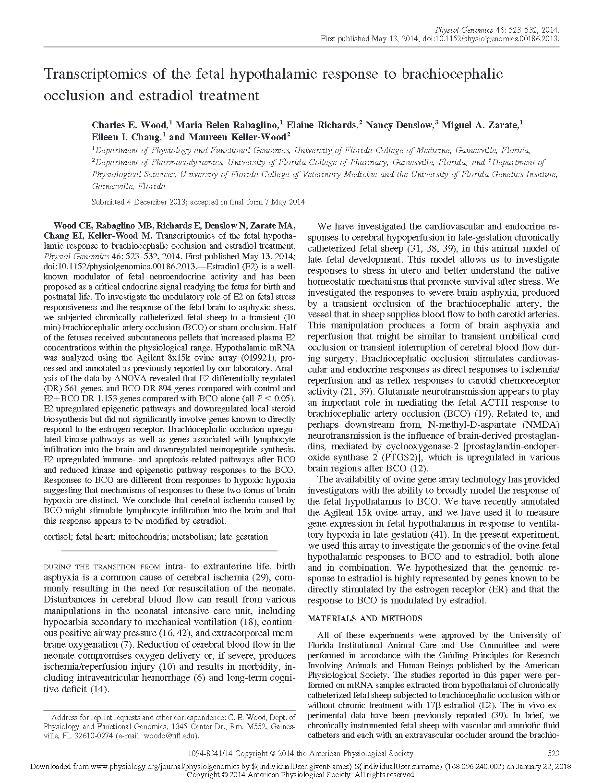Artículo
Transcriptomics of the fetal hypothalamic response to brachiocephalic occlusion and estradiol treatment
Wood, Charles; Rabaglino, Maria Belen ; Richards, Elaine; Denslow, Nancy; Zarate, Miguel A.; Chang, Eileen
; Richards, Elaine; Denslow, Nancy; Zarate, Miguel A.; Chang, Eileen
 ; Richards, Elaine; Denslow, Nancy; Zarate, Miguel A.; Chang, Eileen
; Richards, Elaine; Denslow, Nancy; Zarate, Miguel A.; Chang, Eileen
Fecha de publicación:
05/2014
Editorial:
American Physiological Society
Revista:
Physiological Genomics
ISSN:
1094-8341
Idioma:
Inglés
Tipo de recurso:
Artículo publicado
Clasificación temática:
Resumen
Estradiol (E2) is a well-known modulator of fetal neuroendocrine activity and has been proposed as a critical endocrine signal readying the fetus for birth and postnatal life. To investigate the modulatory role of E2 on fetal stress responsiveness and the response of the fetal brain to asphyxic stress, we subjected chronically catheterized fetal sheep to a transient (10 min) brachiocephalic artery occlusion (BCO) or sham occlusion. Half of the fetuses received subcutaneous pellets that increased plasma E2 concentrations within the physiological range. Hypothalamic mRNA was analyzed using the Agilent 8x15k ovine array (019921), processed and annotated as previously reported by our laboratory. Analysis of the data by ANOVA revealed that E2 differentially regulated (DR) 561 genes, and BCO DR 894 genes compared with control and E2+BCO DR 1,153 genes compared with BCO alone (all P < 0.05). E2 upregulated epigenetic pathways and downregulated local steroid biosynthesis but did not significantly involve genes known to directly respond to the estrogen receptor. Brachiocephalic occlusion upregulated kinase pathways as well as genes associated with lymphocyte infiltration into the brain and downregulated neuropeptide synthesis. E2 upregulated immune- and apoptosis-related pathways after BCO and reduced kinase and epigenetic pathway responses to the BCO. Responses to BCO are different from responses to hypoxic hypoxia suggesting that mechanisms of responses to these two forms of brain hypoxia are distinct. We conclude that cerebral ischemia caused by BCO might stimulate lymphocyte infiltration into the brain and that this response appears to be modified by estradiol. during the transition from intra- to extrauterine life, birth asphyxia is a common cause of cerebral ischemia (29), commonly resulting in the need for resuscitation of the neonate. Disturbances in cerebral blood flow can result from various manipulations in the neonatal intensive care unit, including hypocarbia secondary to mechanical ventilation (18), continuous positive airway pressure (16, 42), and extracorporeal membrane oxygenation (7). Reduction of cerebral blood flow in the neonate compromises oxygen delivery or, if severe, produces ischemia/reperfusion injury (10) and results in morbidity, including intraventricular hemorrhage (6) and long-term cognitive deficit (14). We have investigated the cardiovascular and endocrine responses to cerebral hypoperfusion in late-gestation chronically catheterized fetal sheep (31, 38, 39), in this animal model of late fetal development. This model allows us to investigate responses to stress in utero and better understand the native homeostatic mechanisms that promote survival after stress. We investigated the responses to severe brain asphyxia, produced by a transient occlusion of the brachiocephalic artery, the vessel that in sheep supplies blood flow to both carotid arteries. This manipulation produces a form of brain asphyxia and reperfusion that might be similar to transient umbilical cord occlusion or transient interruption of cerebral blood flow during surgery. Brachiocephalic occlusion stimulates cardiovascular and endocrine responses as direct responses to ischemia/reperfusion and as reflex responses to carotid chemoreceptor activity (21, 39). Glutamate neurotransmission appears to play an important role in mediating the fetal ACTH response to brachiocephalic artery occlusion (BCO) (19). Related to, and perhaps downstream from, N-methyl-D-aspartate (NMDA) neurotransmission is the influence of brain-derived prostaglandins, mediated by cyclooxygenase-2 [prostaglandin-endoperoxide synthase 2 (PTGS2)], which is upregulated in various brain regions after BCO (12). The availability of ovine gene array technology has provided investigators with the ability to broadly model the response of the fetal hypothalamus to BCO. We have recently annotated the Agilent 15k ovine array, and we have used it to measure gene expression in fetal hypothalamus in response to ventilatory hypoxia in late gestation (41). In the present experiment, we used this array to investigate the genomics of the ovine fetal hypothalamic responses to BCO and to estradiol, both alone and in combination. We hypothesized that the genomic response to estradiol is highly represented by genes known to be directly stimulated by the estrogen receptor (ER) and that the response to BCO is modulated by estradiol.
Palabras clave:
Cortisol
,
Fetal Heart
,
Mitochondria
,
Metabolism
,
Late Gestation
Archivos asociados
Licencia
Identificadores
Colecciones
Articulos(CCT - CORDOBA)
Articulos de CTRO.CIENTIFICO TECNOL.CONICET - CORDOBA
Articulos de CTRO.CIENTIFICO TECNOL.CONICET - CORDOBA
Citación
Wood, Charles; Rabaglino, Maria Belen; Richards, Elaine; Denslow, Nancy; Zarate, Miguel A.; et al.; Transcriptomics of the fetal hypothalamic response to brachiocephalic occlusion and estradiol treatment; American Physiological Society; Physiological Genomics; 46; 14; 5-2014; 523-532
Compartir
Altmétricas



